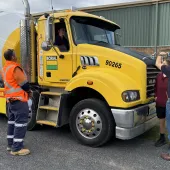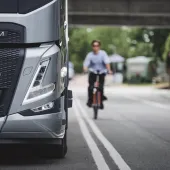Brigade welcome latest version of DVS

Company welcomes proposals to incorporate technology into Direct Vision Standard
BRIGADE Electronics have welcome the Mayor of London’s latest version of the Direct Vision Standard (DVS), which now includes the use of cameras and sensors and says changes to vehicle design cannot replace vehicle safety devices.
In 2016, the Mayor, Sadiq Khan, launched the DVS for HGVs. It was created to improve the safety of all road users but particularly those that are most vulnerable, such as cyclists.
Using a star system, the DVS rates HGVs from zero (lowest) to five (highest), based on how much a HGV driver can see directly through their cab windows, as opposed to indirectly through cameras or mirrors.
The proposals set to be introduced in 2020 will now recognize the use of vehicle safety devices, including cameras and sensors, in addition to the visibility standards required in the cab such as larger windscreens and glass panel doors.
Vehicles with a DVS rating of one star and above would be granted a permit but those rated at zero would require additional safety devices.
Tom Brett, Brigade’s UK managing director, said: ‘The changes to vehicle design to improve driver visibility were a great idea but cannot replace vehicle safety devices and have created their own problems.
‘For instance, the glass panel door on the nearside helps to improve visibility until someone sits in the passenger seat or a bag is placed there. A dirty glass panel or severe weather conditions may also affect visibility.
‘The large windscreens that are supposed to improve driver visibility to the front are also reduced when the oversized sun visors are pulled down, rendering the driver unable to view the class-six mirror and, therefore, creating a blind spot.
‘For all these reasons, 360° cameras systems and ultrasonic proximity sensors are essential to provide the driver with full vision around the vehicle and alert him in the event that he has not seen an obstacle.’
The Freight Transport Association (FTA) has also campaigned for the use of technology to be included in the Direct Vision Standard, but it warns that the final specification is still uncertain.
Natalie Chapman, the FTA’s head of policy for London, said: ‘The FTA has always argued that, in the long term, the really significant road safety improvements we want will be delivered through technology and we are glad that this point, which we have made repeatedly to the Mayor and Transport for London, is now being listened to.
‘However, to ensure that the capital’s businesses are able to plan and function effectively, it is imperative we have clarity as soon as possible about what the final DVS scheme is going to require.’
Tom Brett concluded: ‘Most vehicle specifications, including FORS and CLOCS, and those for Skanska and HS2, require the fitting of cameras, sensors and reversing alarms. The Mayor’s latest proposals, it seems, are only just recognizing that trend and bringing the DVS in line with what is already widely accepted as the norm.’









